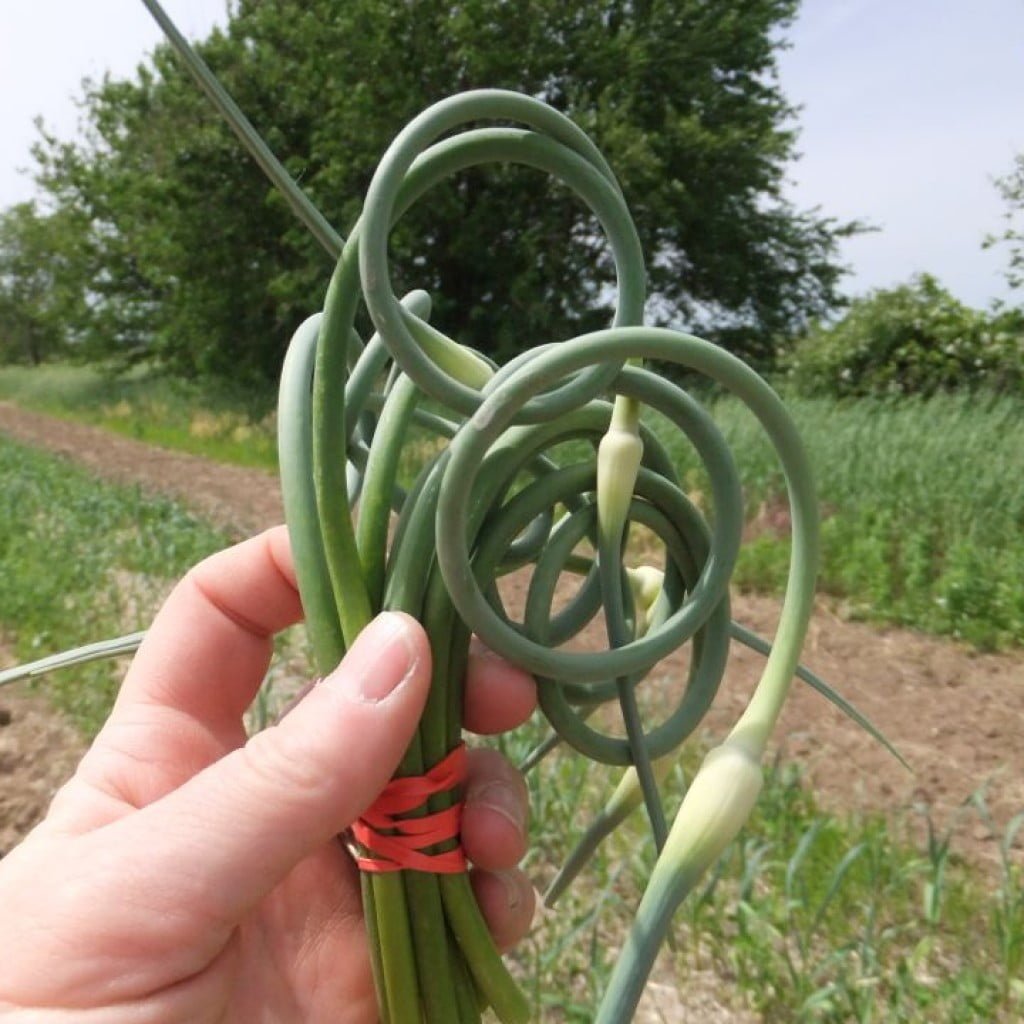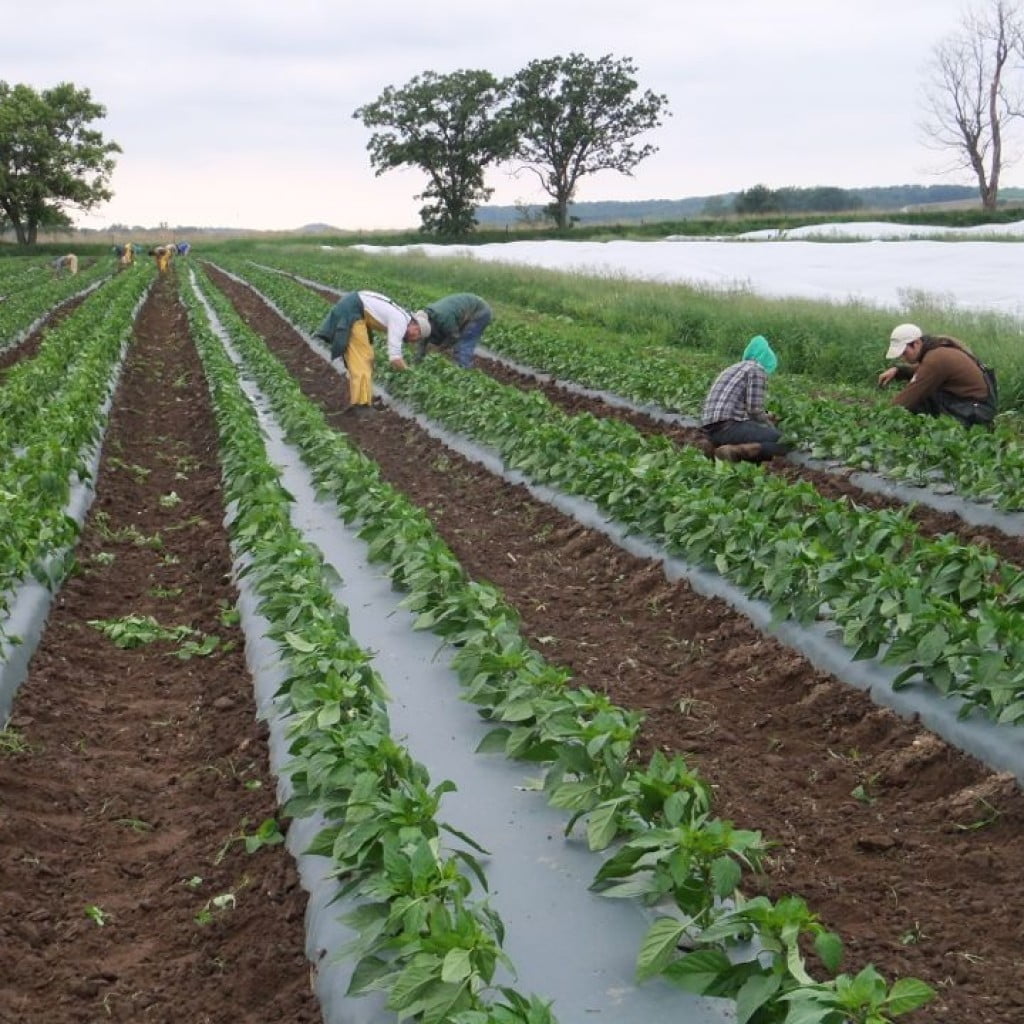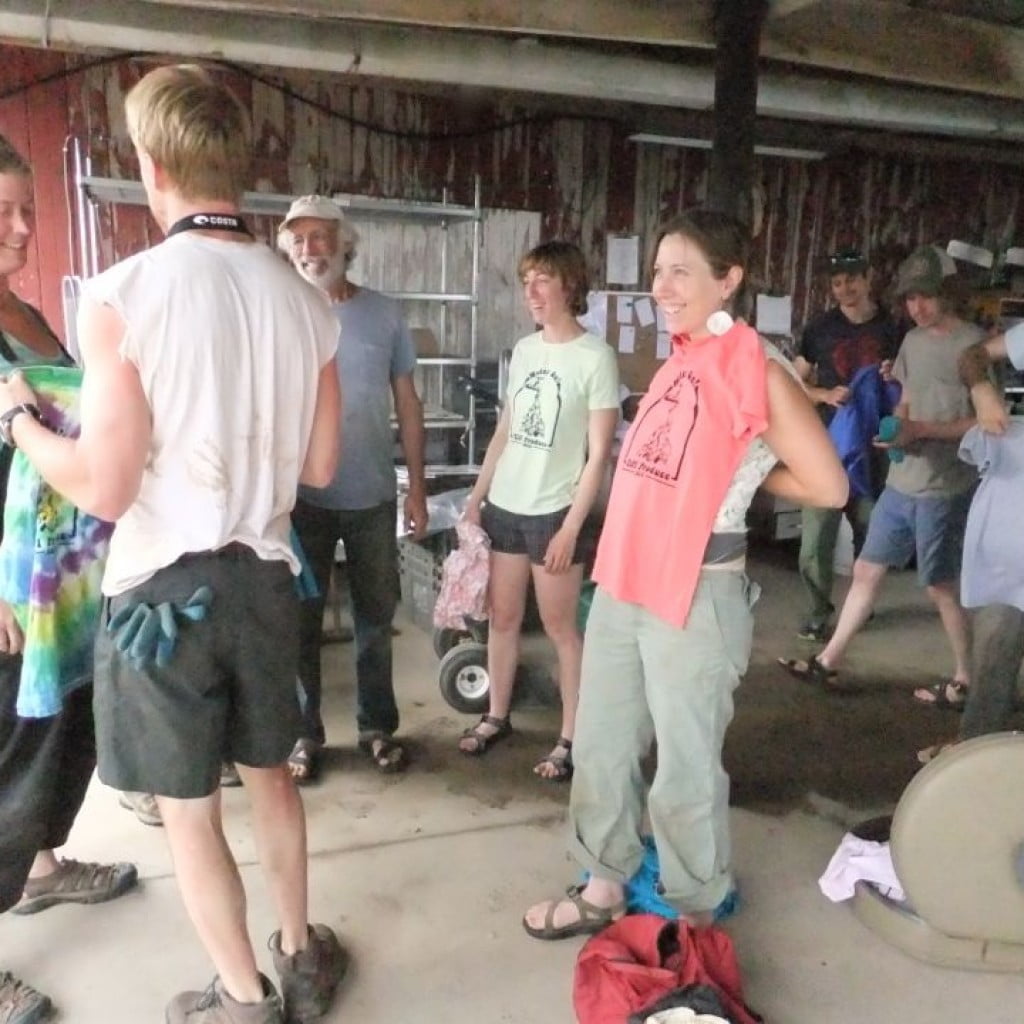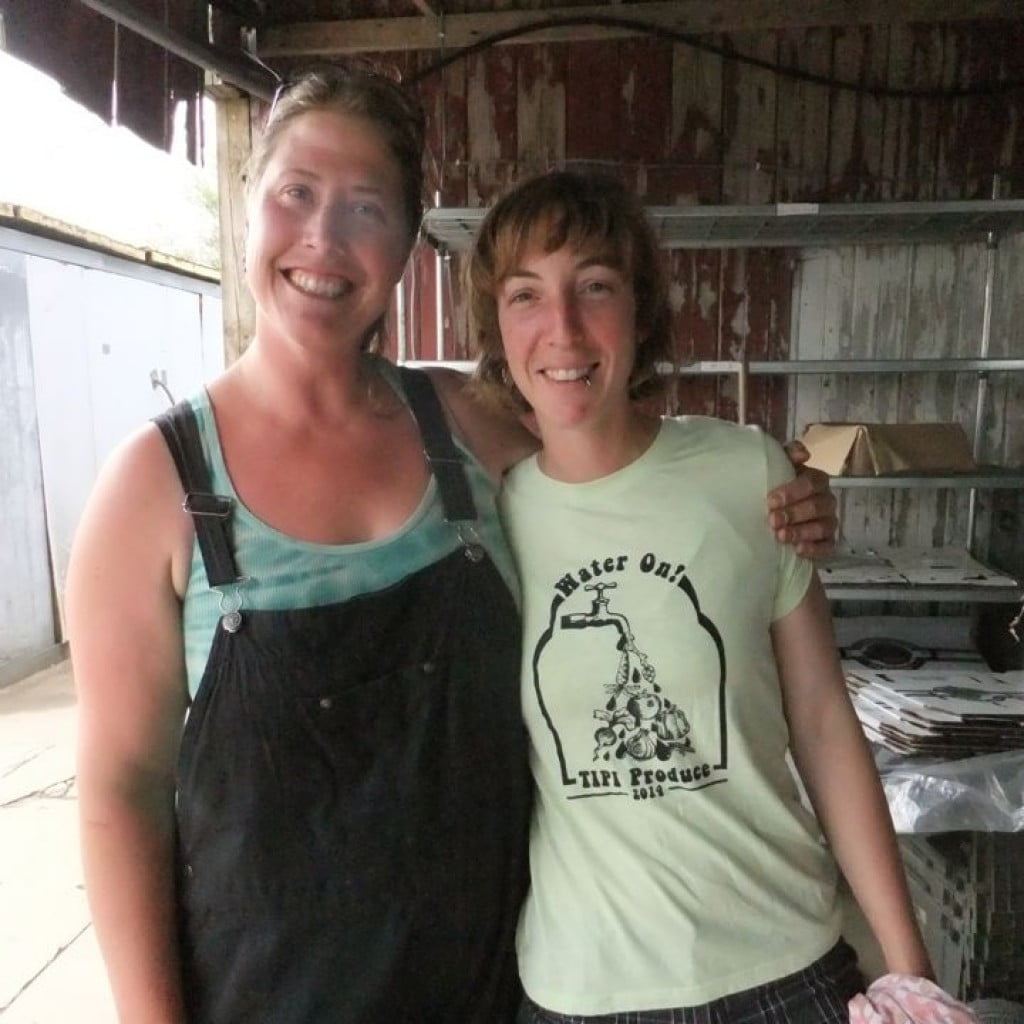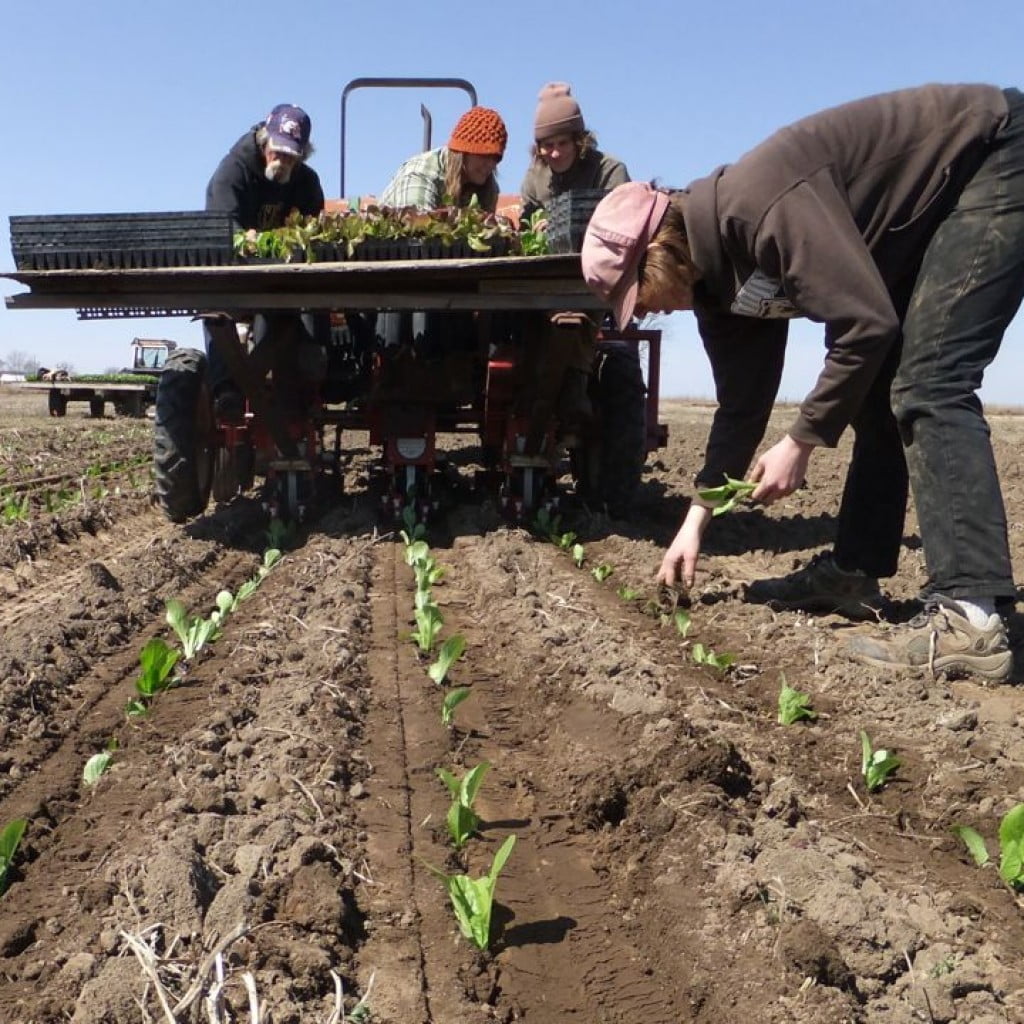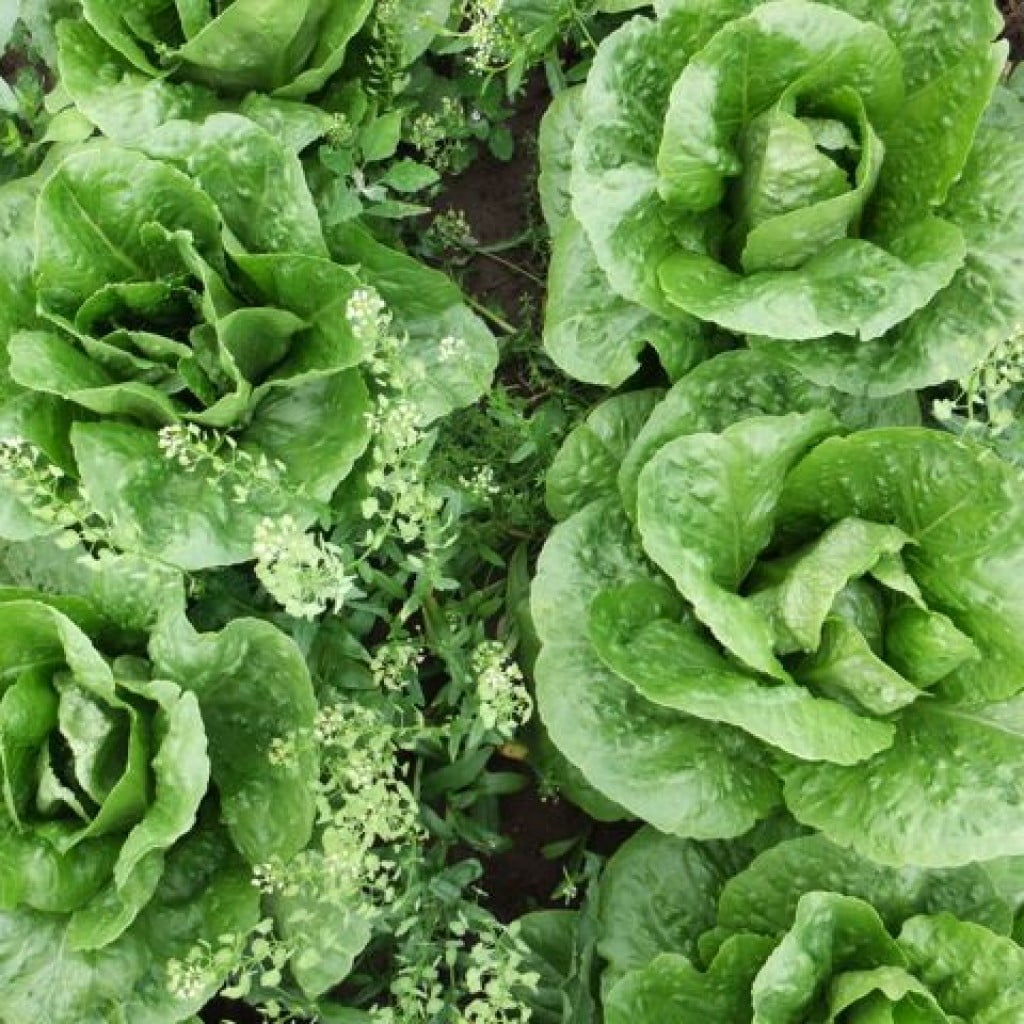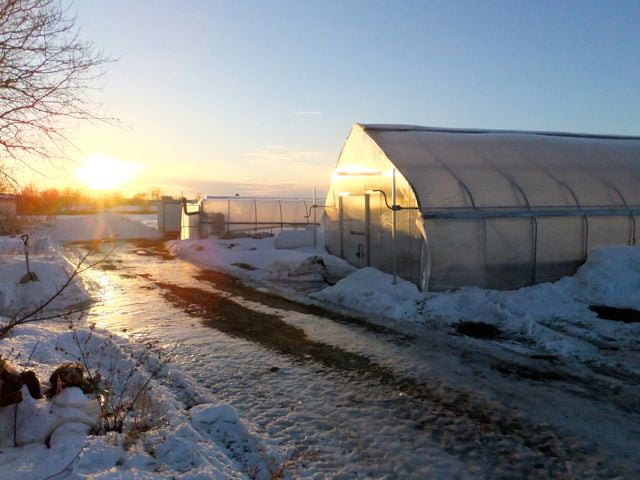Blog
Next steps
- On: June 18, 2014
 0
0
Let’s review our CSA delivery schedule for the week of July 4.
That’s the next green EOW delivery.
– Evansville, Madison, Middleton and Oregon deliveries will be on Thursday, July 3, as expected.
– Milwaukee area and Janesville deliveries will be on Thursday July 3 to avoid the July 4 holiday.
Strawberry U-Picks
Please read our emails for info about upcoming strawberry u-picks here at the farm.
Food Preservation Volunteers Needed at the Goodman Center in Madison
Tipi member Amy Mach coordinates this program, which allows you to learn new skills or put your current preservation skills to good use. Amy writes “Help preserve nature’s bounty as a volunteer in the Goodman Community Center’s food preservation program. No experience necessary! The Community Center is located on the eastside of Madison. The produce you preserve will fill the shelves of the Fritz food pantry with healthy local food. Last year, volunteers in this important program were able to can, dehydrate and freeze 3,000 pounds of local fruits and vegetables, helping to feed the 100+ families per week that our food pantry supports year-round. Enjoy a flexible schedule of one 3-4 hour shift per week. Choose between daytime, evening and weekend opportunities that fit your calendar!”
Attend one of their informational sessions. Each session is 2 hours long and includes new volunteer orientation.
June 19th at 3pm
June 30th at 5pm
Please RSVP to Amy Mach, amymach(at)goodmancenter.org or 608.241.1574 x227
Farm Progress
The tornados and severe storms missed our farm this week. I hope all of you are faring OK, and the storms missed you too.
We uncovered our zucchini and cucumber fields last week. We keep the plants under floating row cover in early spring to protect them from frost and to speed their growth. Of course, weeds also grow faster under row cover. They’re a cover crop as long as they don’t set seed, right? We tackled the weeds on Monday before the big storms. The squash plants are uncovered, the bees can pollinate the blossoms, and we’ll have squash for you next week. Beth
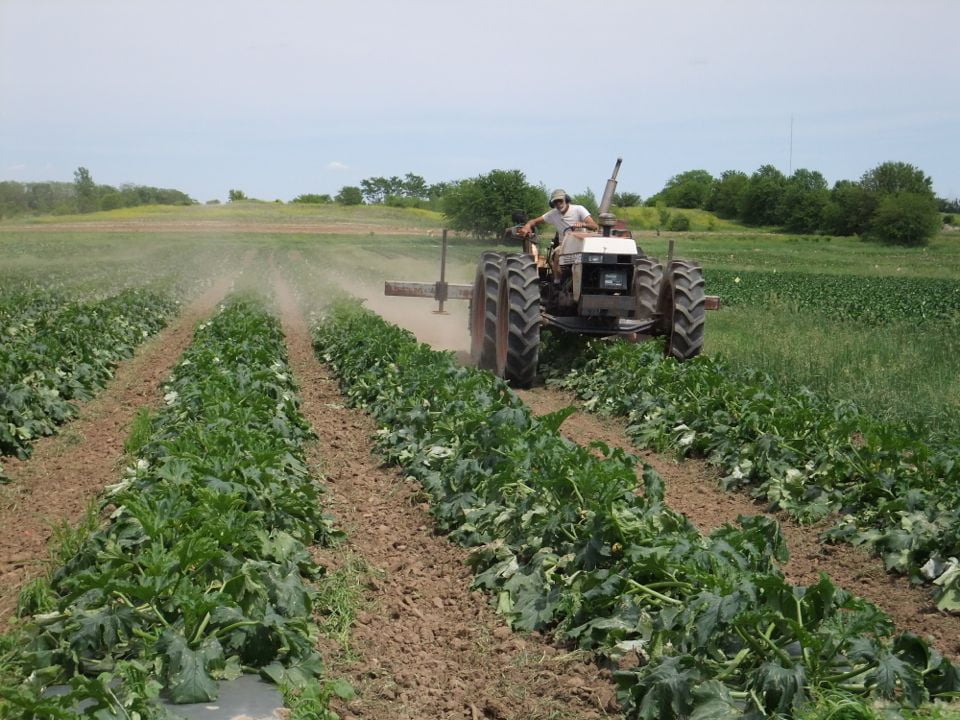
Steve cultivates the zucchini field. He moves along quickly. Steve and Michael were cultivating at the same time on Monday, a race to get the work done while the fields were still dry.
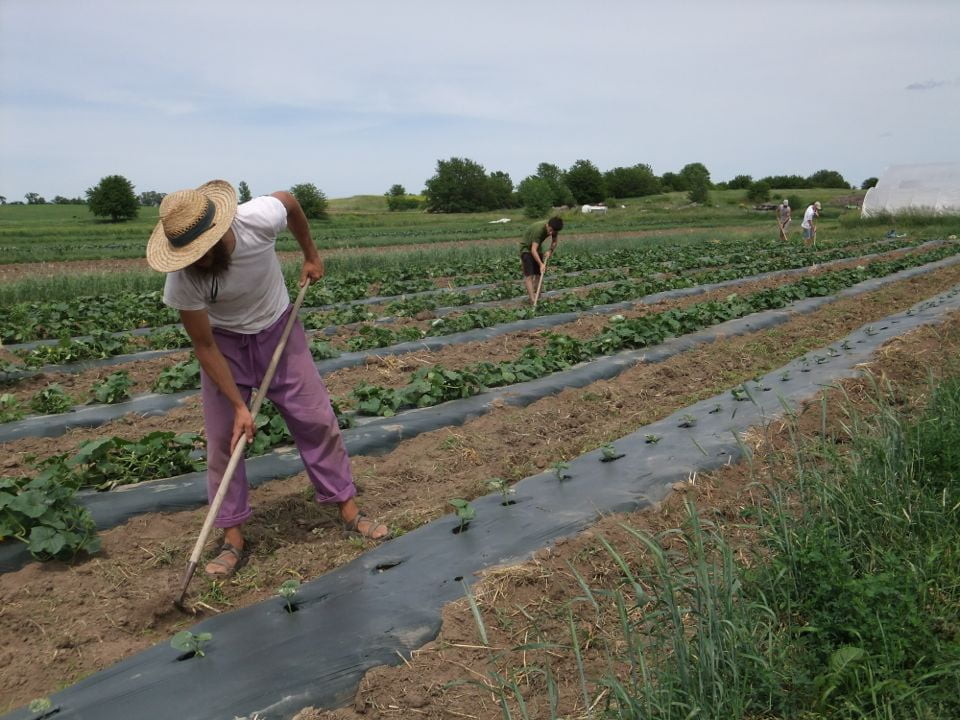
Clint, Peter and others follow up with hoes in the cucumber field. The tractor gets most weeds but never all of them.
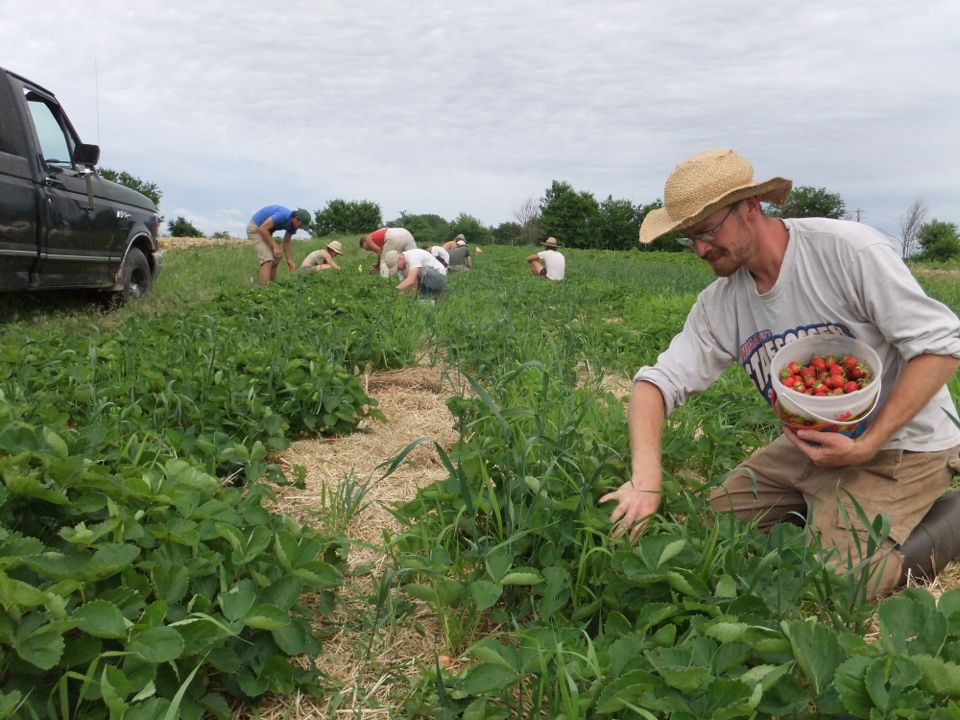
Billy (and others) pick your strawberries.
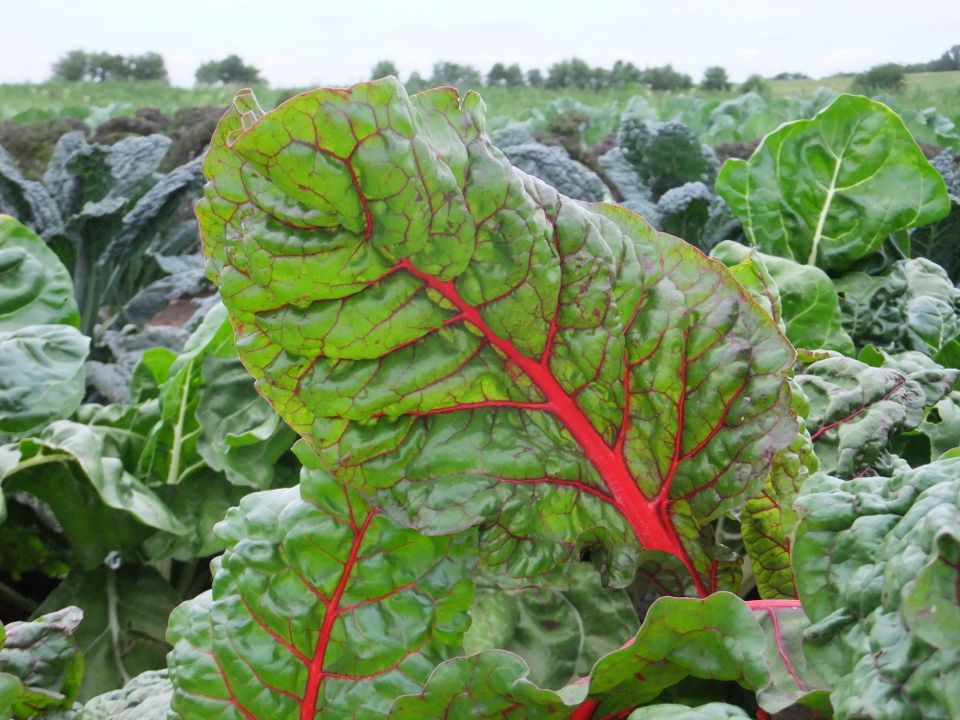
Red Swiss chard. Steve plants rows of red, pink, yellow and white chard next to each other so we can easily make colorful bunches. This is its natural color, not Photoshopped.
Veggie List and Veggie Notes (6/19/2014, week #5, green EOW)
Strawberries, 1 quart or 2 pints
Asparagus, 1 lb
Snap peas, 1 lb
Snow peas, 1/4 lb
(The snap and snow peas are combined in one bag.)
Swiss chard, 1 medium bunch
Green leaf lettuce, 1
Green cabbage, 1, about 2 to 2.5 lb
Scallions, 1 large bunch
Garlic scapes
Next week’s box will probably contain strawberries, zucchini or summer squash, peas, napa cabbage, daikon radish, scallions, garlic scapes, rhubarb and more.
Strawberries! We’ve been waiting for these.
♦ Strawberries are perishable. Ripe berries should be eaten immediately, or stored in the refrigerator. Most berries are quite clean. If you want to clean your berries, rinse gently. Don’t soak them, just rinse. Do not be concerned if you receive a partially-filled container. Sometimes we fill them partially in order to distribute berries to all the members.
♦ Please recycle your strawberry containers this year. We no longer collect them for re-use.
Snap peas (plump pea pods) – These peas should be eaten pod and all. They are delicious raw, or very lightly cooked or stir-fried. They might need a quick rinse to remove faded gray blossoms. Store in the refrigerator. Here’s how to remove the strings from the snap peas. Snap off the stem end and pull the string down the concave side of the pod (the inward-curing side). Throw away the string and eat the pod.
Snow peas (flat pea pods) – These are excellent stir fried or in raw salads. The thicker pea pods will usually have two strings along the edges. Remove them when you snap the stem off.
Swiss chard (pretty bundle of greens with mixed-color stems) – This is a close relative of spinach, but requires a bit more cooking. Use as a substitute in any recipe that calls for spinach, just cook the chard a little longer. Both stems and leaves are delicious. The stems requite longer cooking, so cut them free from the leaves when preparing. That allows you to cook the stems longer.
Cabbage – This ia a nice salad-type that we grow in summer. Don’t you love the pointy shape? It has thinner, more tender leaves than the usual green cabbage. Great in salads and slaws but can also be cooked. Most of this week’s cabbage weigh between 2 and 2.5 lb.
Garlic scapes (curly green things) – Garlic scapes grow at the top of garlic plants. They look like flower buds but are actually clusters of tiny bulblets. It’s important to snap off the young scapes to direct the plants’ energy into forming garlic bulbs underground. Use scapes as a substitute for garlic cloves. They can be minced, mixed with olive oil, and added to stir fries or simple pasta dishes. The scapes can be sautéed, but will not brown like garlic cloves. Expect them to retain their crunch even when cooked, and to be milder than garlic cloves, closer in pungency to the green garlic we’ve sent.
Most of the scapes are from John Hendrickson of Stone Circle Farm who grows organic garlic for our CSA. We planted a small field of garlic last fall, providing more scapes.
Empty greenhouses, full fields
- On: June 11, 2014
 0
0
We finished an intense burst of field work last week. Under threat of coming rain, Steve and the crew rushed to transplant our seedlings into the field. We emptied two full greenhouses, a total of 50,000 plants. Everyone worked so hard. We have reviewed and practiced our hand signals this spring for communication with our tractor drivers. For example, we circle a finger in the air to say “speed up.” Simone looked back from the tractor during pepper transplanting. Clint was planting so quickly with both hands that he couldn’t even manage the hand signal, just a big grin and a nod of the head. Sturdy pepper seedlings can handle that kind of speed. We slow down for melons and cucumbers because their roots are fragile and they need gentle handling. Handle them roughly during transplanting and many plants will die.
Steve reviewed the accomplishments at the end of the week, thanked everyone, and announced “Of course, all of those fields will need weeding in 10 days.” That was a sobering moment. Fortunately, the work goes quickly with a large group of people. I asked Steve why we were able to complete so much in one week. He said it was the cohesive crew, terrific plants, cooperative weather. Personally, I think it was the new t-shirts.
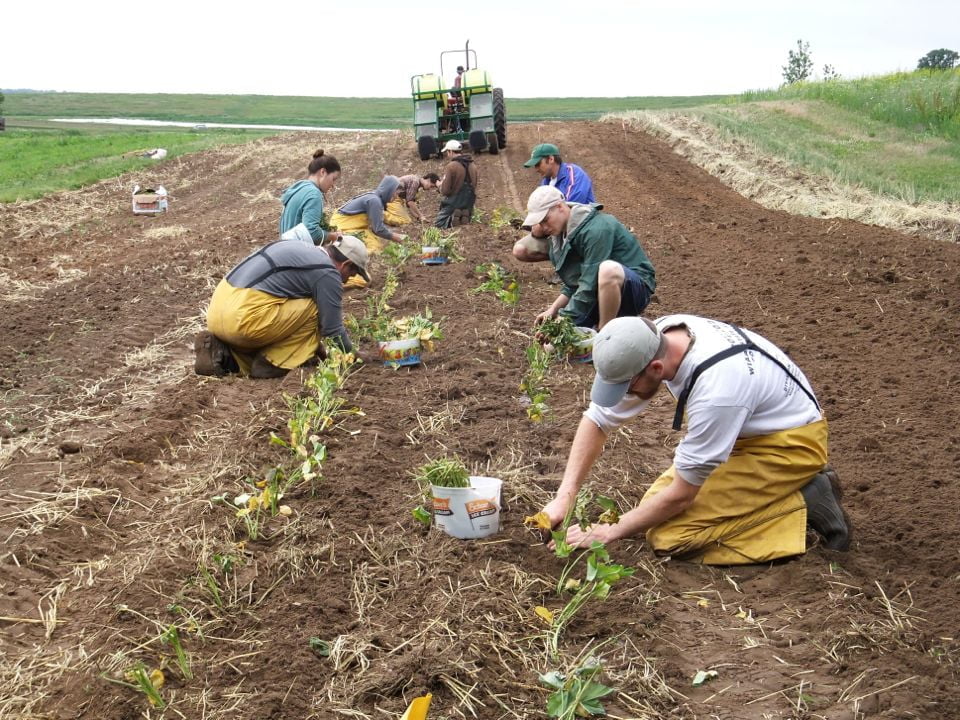
See what we can accomplish as a group? Planting sweet potato slips.
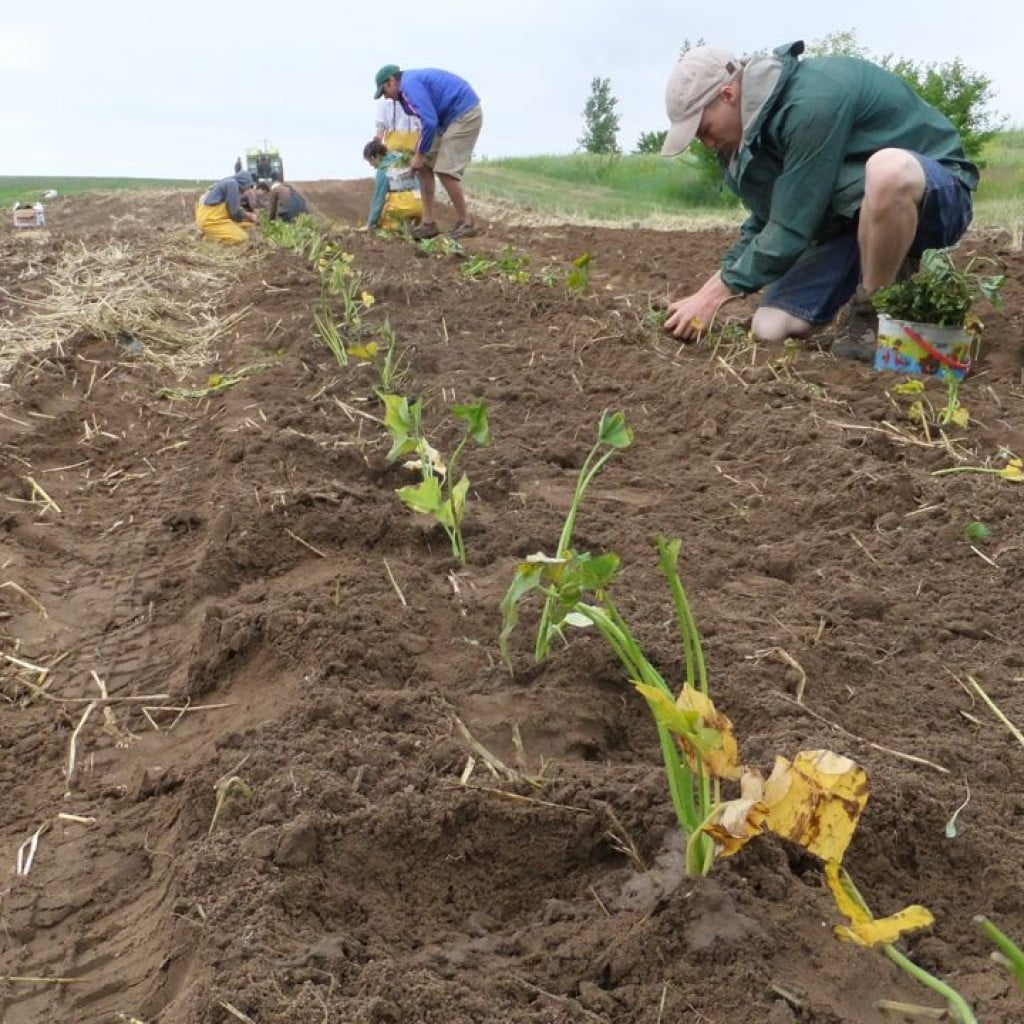
These tiny cuttings will grow into ten foot vines.
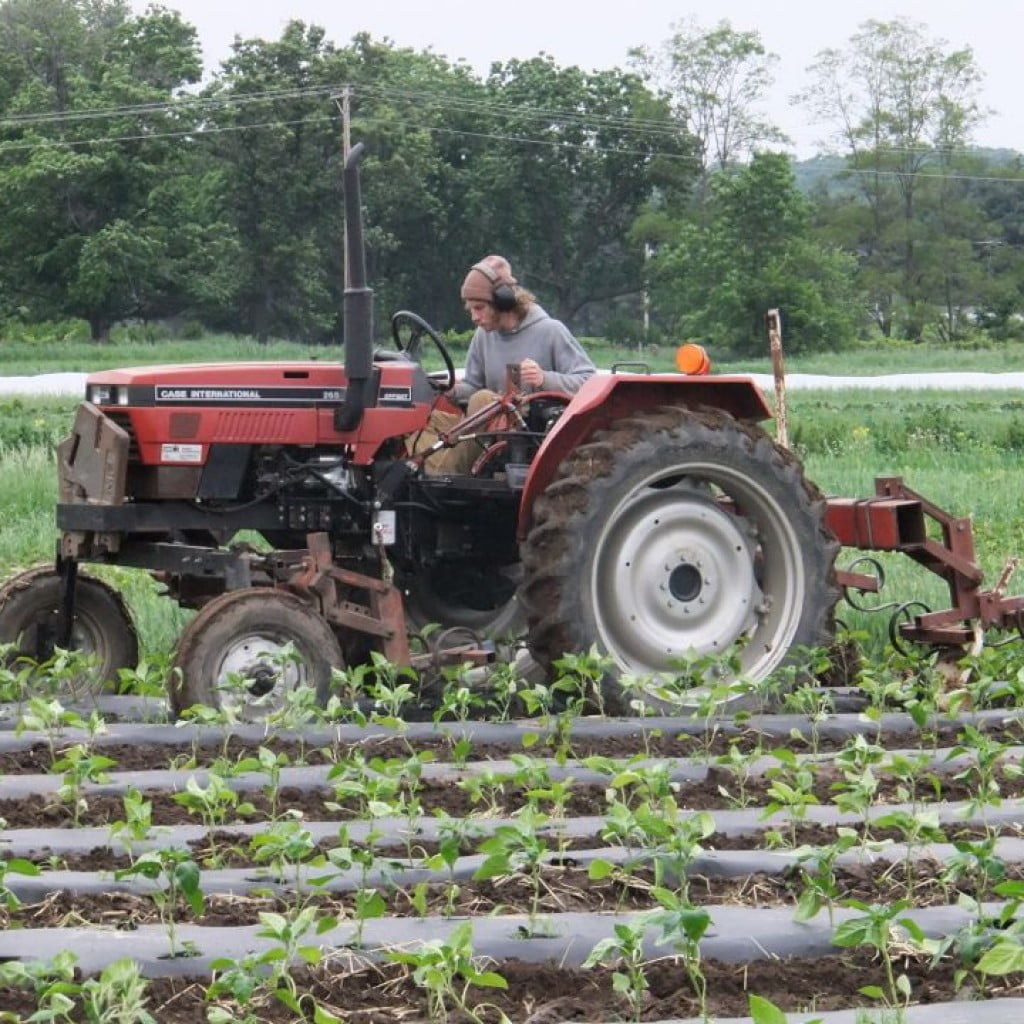
Steve is teaching Michael to cultivate. Here, he cultivates weeds at the edge of plastic mulch in our pepper fields. This job takes great concentration.
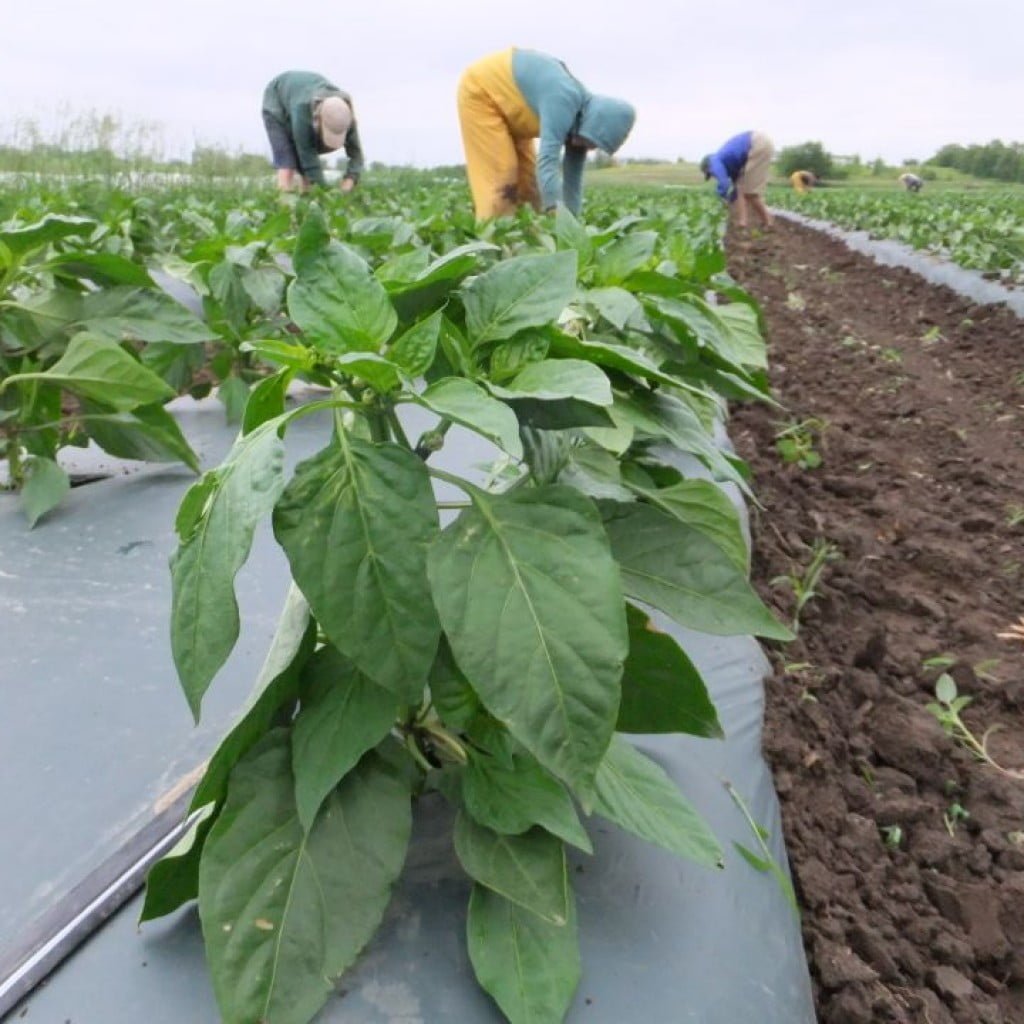
The pepper plants are thriving.
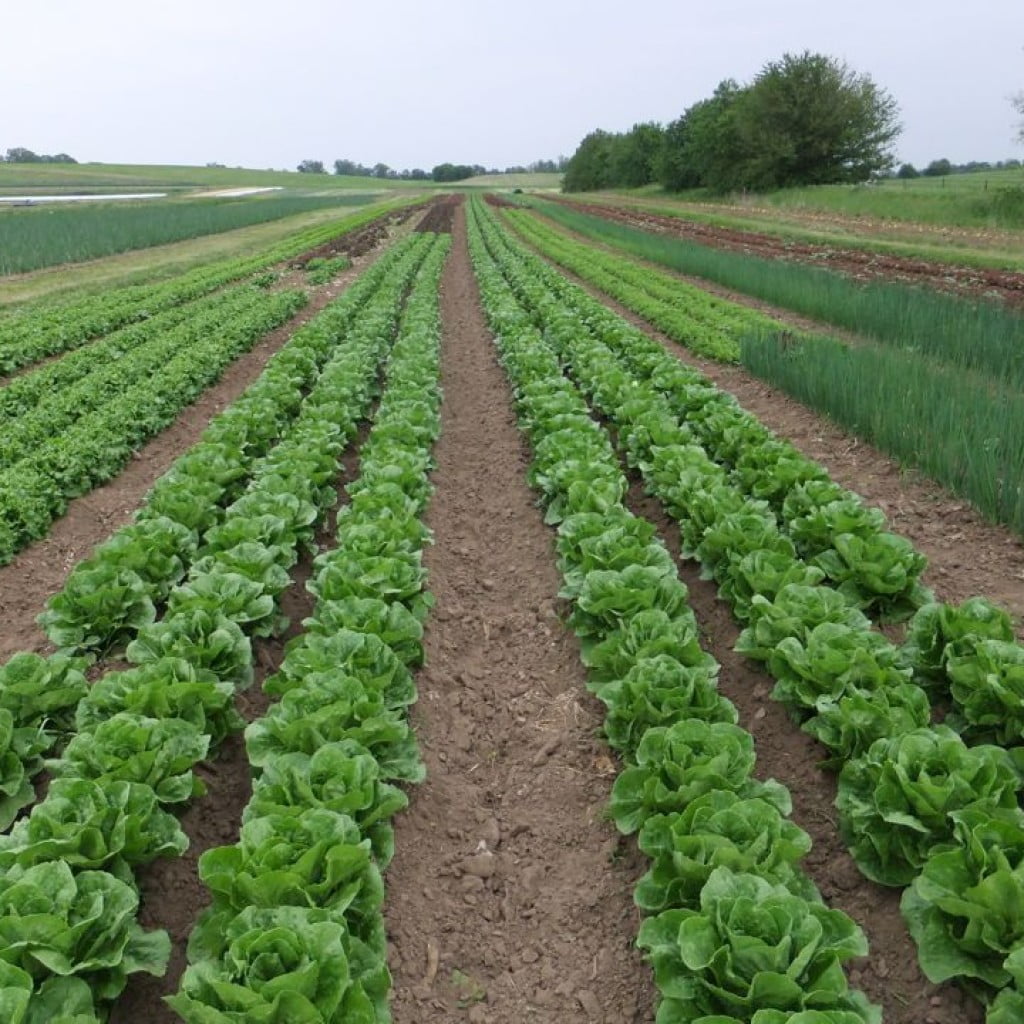
All the colors are so lovely right now. From left, endive, lettuce and scallions, ready to harvest.
A Wrinkle in Local Thyme (LT) registration
Pat wants you to know that each member’s registration will end one year after you first registered. LT has worked for some of you without renewal this year, but will lapse on the anniversary of last year’s registration. Send me an email titled “LT please” if you need the registration instructions and code.
Veggie List and Veggie Notes (6/12/14, week #4, purple EOW)
This is the year of giant spring vegetables. We’ve had great growing weather and everything is big. Quality remains excellent. Again, we encourage you to wash your produce carefully (especially asparagus, lettuce, escarole and spinach) because of the recent rains.
Asparagus, 1.3 lb
Red leaf lettuce, 1 head
Spinach, 1 large bunch, about 1.75 lb
Escarole, 1 head
White salad turnips, 1 bunch
Scallions, 1 bunch
Kohlrabi, 1
A few members will get a small head of broccoli.
Next week’s box will contain PEAS plus a few incidentals like asparagus, chard or kale, lettuce, scallions, garlic scapes, and more.
Escarole (large head of wavy green leaves) – This member of the chicory family can be eaten raw or cooked. Its slightly bitter flavor is a good addition to mixed salads. It is excellent cooked alone or mixed with other greens. It cooks quickly, but not as quickly as spinach. Refrigerate.
Kohlrabi (pale green globe with crisp white interior) – Kolrabi is an unusual vegetable that I enjoy introducing to new CSA members because almost everyone likes it. Crunchy and sweet, it’s a great addition to salads.
Storage: Kohlrabi bulbs will store for a month in the refrigerator.
Uses: Kohlrabi are good peeled and eaten out of hand, or added to sandwiches. It is good mixed into salads, or prepared as a salad on it’s own. You can grate it, slice it, or cut it into matchsticks. It’s also good cooked. If you have it, the Asparagus to Zucchini cookbook has a long list of kohlrabi suggestions.
Creative woman
- On: June 04, 2014
 0
0
Longterm Tipi farmhand Maggie Schley brought special gifts to work last week. She hauled out a suitcase during our morning meeting and presented everyone with new Tipi farm shirts she designed. She selected a special shirt for each person. Mine’s a lovely shade of green! This creative woman spins, weaves, knits, shellacs walls with onion skins, preserves tons of food, and even knit her own wedding dress. Thank you Maggie!
from left, Maggie shares new shirts with David, Steve, Kerry, Bonnie, Tristan and Michael.
Kerry (right) models Maggie’s (left) new farm shirt.
The t-shirts are printed with “Water On! Tipi Produce 2014.” Maggie’s had this design in mind for years. The phrase “water on” means a lot on our farm. It’s the first thing we say during the first outside job every spring. We use mechanical transplanters when planting our greenhouse-grown plants into the field. When the riders on the transplanter are ready for the tractor driver to move, they holler (OK, scream at the top of their lungs) “WATER ON!” It’s a sign that the water valve is open and gushing and it’s time to get moving.
From left, Larry, Maggie and Michael ride the transplanter while Kerry makes sure the seedlings are at the proper depth. The tractor pulling the transplanter is hidden to the rear. You can just see its tall roll bar.
The photo above was taken April 9, the day we transplanted the lettuce you will receive this week. Those are Romaine seedlings in the photo. Here they are now, festooned with field pennycress. No, we didn’t send the pretty weeds along with the lettuce this week.
It’s time to deposit the June 1 checks.
Many of you paid us with checks dated June 1. I will deposit the checks this Friday June 6.
Veggie List and Veggie Notes (6/5/14, week #3, GREEN EOW)
The rain was welcome this week, but splashed soil into the vegetables again. Everything needs extra washing, especially lettuce, spinach and asparagus. Dunk repeatedly in cold water until the water remains clean.
Asparagus, 1.3 lb
Spinach, 1 bunch, about 2 lb total
Romaine lettuce, 1 large
White salad turnips, 1 bunch
Mustard greens, 1 medium bunch
Green garlic, 1 small bunch
Cilantro, 1 small bunch
Next week’s box will probably contain asparagus, spinach, lettuce, white salad turnips, escarole, scallions and more.
Asparagus – Wash this asparagus well to remove grit.
Spinach – We usually tell you if the spinach is “salad-quality” or “cooking quality.” “Salad-quality” spinach is thin-leaved and tender, and shrinks substantially when cooked. “Cooking-quality” spinach is thicker-leaved and shrinks less during cooking. This week’s spinach is definitely salad-quality but we encourage you to use both ways because we are sending so much. The spinach has grown well this spring! Steam, chop and freeze any extra. You’ll be glad to have it ready to add to soups, casseroles, etc.
Romaine – Well, these are enormous. This is really nice Romaine; it was an enthusiastic grower this week. It’s time to make Caesar’s Salad.
White salad turnips – I know that returning members look forward to these sweet and delicious turnips, which taste nothing like the turnips that we harvest in fall.
– Storage: Cover and refrigerate.
– Uses: Both the turnip roots and tops are edible. Slice the sweet roots and add to salads. The roots can be cooked and are especially good when lightly sauteed in butter. Stir as little as possible so they brown on at least one side. The turnip greens are excellent cooked. Treat them like mustard greens.
– Our favorite use: Slice the roots very thinly and combine with a mixture of rice vinegar, mirin, soy sauce, sesame oil. Eat immediately or marinate.
Mustard greens – These spicy greens are so young and tender that you can use them raw in salads. They are excellent cooked until wilted, but will shrink considerably.
Green garlic – Last fall, we planted garlic cloves that grew into the stalks we’ve sent today. If left to grow until mid-summer, the slim white bulb on this week’s garlic would divide and form the usual cluster of cloves in a garlic bulb. The bunches are small this year. Remember the poor garlic crop in the Midwest last year? We could only obtain tiny heads of garlic to plant in fall. Small garlic bulbs lead to small green garlic bunches.
– Green garlic is more pungent than scallions, so slice thinly and use sparingly when raw. It mellows when cooked. Chop and add to any cooked dish that would benefit from garlic. Use the white bulbs and pale green stems. Avoid the dark green stems and leaves, as these are fibrous.
Cilantro – This herb is good in salsa, chutneys and salad dressings, or added to stir-fries. Used in Mexican, Asian and Indian cooking.
May 29 2014
- On: June 01, 2014
 0
0
No newsletter this week; the internet was spotty on Wednesday night.
Veggie List and Veggie Notes
We were glad to get rain this week, but it splashed soil into most crops. Everything needs extra washing, especially lettuce, bok choy and asparagus. See last week’s newsletter for advice on washing asparagus.
This week’s box contains:
Asparagus, 1.4 lb
Spinach, 1 large bunch, 1 to 1.25 lb
Bok choy, 1 medium head
Red bibb lettuce
Arugula, 1 bunch
Salad radishes, one bunch
Button mushrooms, 12 oz
Rhubarb, 1.5 lb
Next week’s box will probably contain asparagus, spinach, lettuce, white salad turnips, spring greens and scallions or green garlic.
Asparagus – Wash this asparagus well to remove grit.
Spinach – The spinach has grown thicker leaves since last week. It will be excellent lightly cooked, or in salads.
Bok choy – These heads have more insect damage than usual. We took the row cover off these plants so they wouldn’t get too hot and start to flower, but exposed them to flea beetles as a result. This is always the tradeoff in spring.
Red bibb lettuce – Isn’t this lettuce lovely? Bibb lettuce is very tender so handle gently.
Button mushrooms – These organic mushrooms are from Hidden Valley Mushrooms north of Madison. We buy mushrooms from Mary every year; they are a great addition to spring salads and quiches.
It’s time.
- On: May 21, 2014
 0
0
It’s time to start eating fresh food again! Our CSA deliveries begin this week for weekly members and for green every-other-week (EOW) members. Purple EOW, your first delivery is next week.
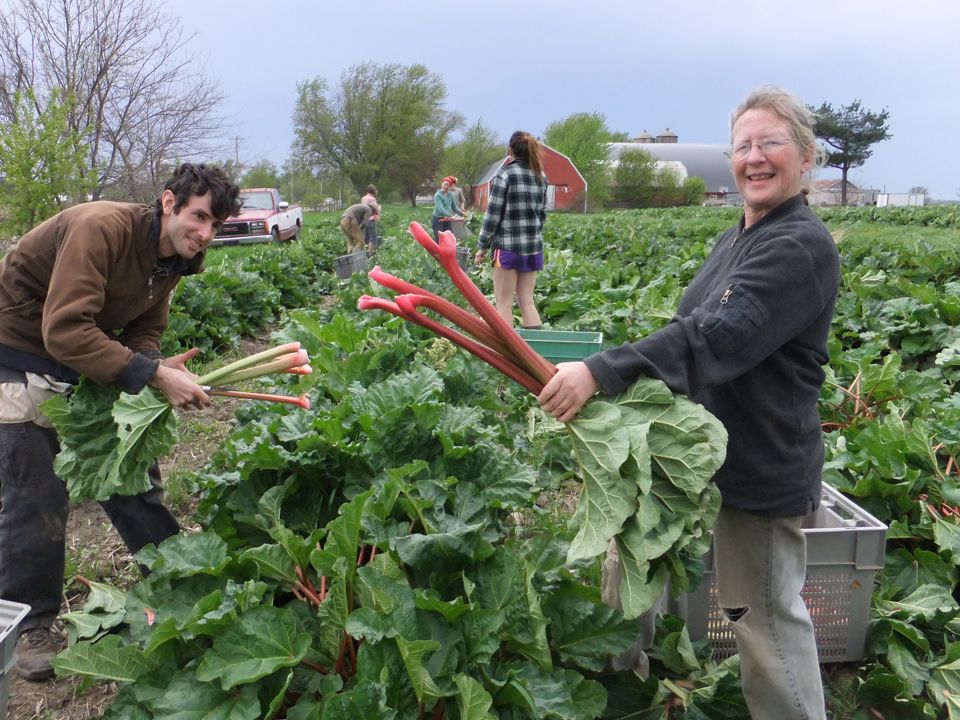
Simone, Jon and others harvest rhubarb.
Things you need to know.
♦ We post this newsletter/blog online each Wednesday night, with the list of veggies for the week, the quantities, information about storage and preparation, plus news of the farm. We’ll send an email on Wednesday night to alert you once the newsletter is ready to read.
♦ EOW and weekly members, we assume that you read all the newsletters, even on your “off” weeks. The newsletter (and our emails to you) are our means to communicate with you.
♦ The first few boxes of the season are always the lightest. EOW members, please do not worry that you have signed up for the wrong share. Our deliveries get heavier and more abundant as the season progresses.
♦ Pat Mulvey of Local Thyme will prepare menus and recipes for us again this year, but you have to register on her website for access. It’s free for Tipi CSA members. Go to www.localthyme.net/register and enter the access code that I sent in my May 2 email. If you need the code or instructions again, send me an email titled “LT please.”
Farm News
Most of our spring work involves planting for future harvests. It feels novel to harvest something!
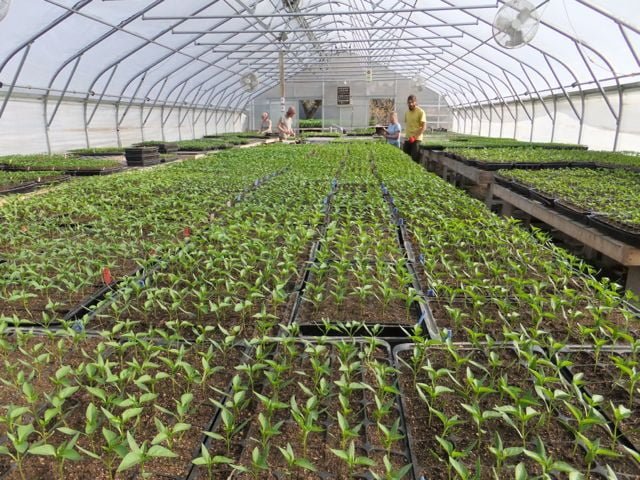
There’s always a moment when we ask ourselves if we’ve planted too many peppers. The answer is “No, you cannot have too many peppers.” The seedlings in the photo above are from our second pepper seeding. These will be large enough to transplant to the field next week.
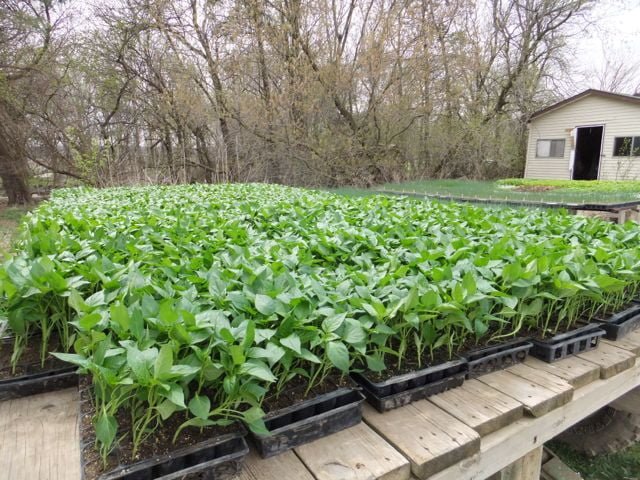
This is the first pepper planting. These babies are already out in the field and growing.
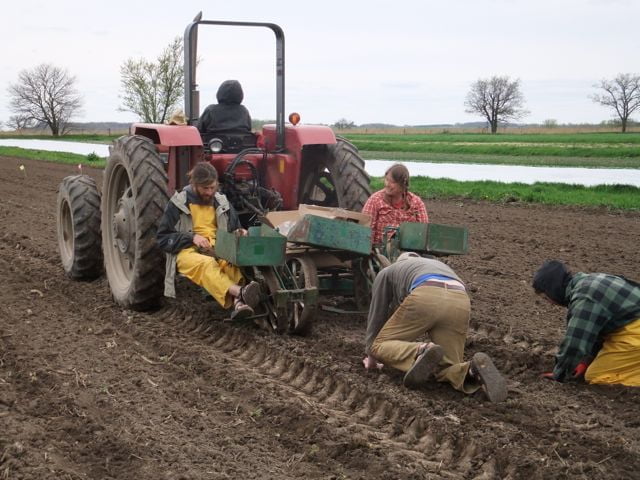
We planted next year’s strawberry field before this year’s crop even flowered. Above, Clint and Maggie ride the strawberry transplanter. Simone drives, Michael and Bonnie settle the plants.
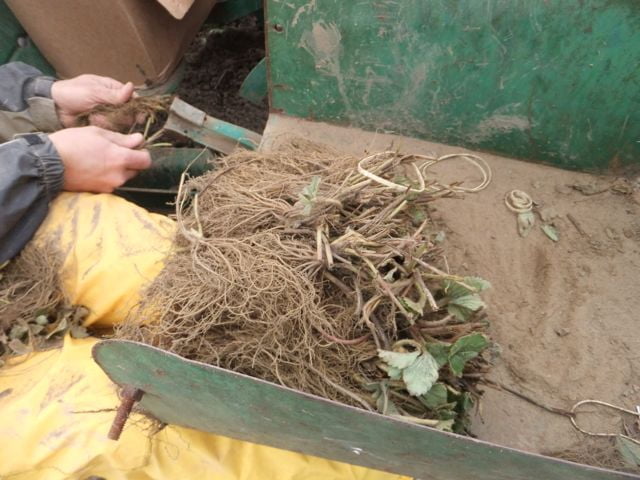
The new berry plants come to us with their tops sheared to lessen transplant shock. They perk up and start growing within a few days.
Veggie Notes (week #1, green EOW members).
We list the week’s veggies and quantities in this section, as well as information about individual vegetables. We’ll share our list of expected vegetables for the following week. I provide extra info on cooking and storage the first week that we send a vegetable. Does an item need extra washing? Does it have special qualities? This is the place to find out. For example, please, please refrigerate the potatoes. We explain the reason below.
Asparagus, 1.8 lb
Spinach, 1 to 1.25 lb
Green leaf lettuce
Arugula, one tender bunch
Salad radishes, one bunch
Goldrush russet potatoes, 3.5 lb
Rhubarb, 2 lb
Next week’s box will probably contain asparagus, spinach, lettuce, arugula, radishes, button mushrooms, bok choy and rhubarb. Maybe green garlic too.
Asparagus – Enjoy this spring treat! You will receive asparagus in a paper bag, including a small bundle tied with a rubber band. Use the rubber-banded asparagus first because it is older. Your asparagus will be green or purple. The purple variety turns dark green when cooked. Its flavor is almost identical to normal green asparagus. You must wash this asparagus thoroughly to remove hidden grit. Submerge it in water, soak briefly, then swish vigorously and pull out of the water with the tips pointing down. The draining action helps pull the grit out of the asparagus tips. Repeat several times.
Storage: Asparagus is perishable, so eat it as soon as possible. To store it, wrap the bundle in paper or cloth and store it loosely in a plastic bag. The asparagus tips tend to rot if in direct contact with the plastic bag. We snap our asparagus at harvest, rather than cutting it. Therefore, there is no need to snap the stalks to remove fibrous ends. For the same reason, it is not necessary to peel the asparagus stalks. It’s OK to trim the end a bit.
Cooking: If your asparagus stalks vary greatly in size, you will want to cook the thicker ones longer. Put the asparagus in a steamer pot over water. Alternatively, you can lay spears flat in the bottom of a broad pan, with ½ inch of water. Cover and steam over medium heat until just tender. Use two forks or a spatula to turn the asparagus during cooking, rotating the bottom spears to the top. Drain and serve. Also excellent broiled or grilled. Good dressed with vinaigrette, or simply with lime juice, salt and pepper.
Rhubarb – Refrigerate in a plastic bag. FYI, 2 lb of rhubarb yields about 6 to 6.5 cups when chopped.
Stewed rhubarb: This is the simplest way to prepare rhubarb. Chop rhubarb into one inch chunks. Stir over medium heat with a small amount of water in the bottom of the pan. The rhubarb will release moisture as it cooks. Stew until it softens and falls apart. Sweeten to taste with honey or sugar. Eat warm on its own, over vanilla ice cream, on pancakes, etc.
Goldrush russet potatoes – Please refrigerate these potatoes. They are in great shape now but will sprout within days if stored at room temperature. They’ve been stored all winter and want to grow. Store in a paper bag to protect from light, even in the fridge. We grow everything we send in our CSA boxes except potatoes, garlic and mushrooms, which we buy from organic growers that we trust. We purchased these potatoes from Jesse Perkins at Vermont Valley Farm. Jesse says the potatoes have a higher sugar content because of starch to sugar conversion during cold storage. The potatoes taste a bit sweet, and will blacken slightly when fried. It’s a harmless color change due to the sugar conversion.
Arugula – (small bunch of green leaves with pungent scent) – Arugula is good mixed with lettuce or spinach in salads, or added to cooked dishes such as lasagne or quiche. I love it on sandwiches. This arugula is thin-leaved and tender and will not store for long. Eat soon. It wilted a bit while we were harvesting it. That’s what happens when you keep it sheltered under row cover (to protect from insects), then pull off the row cover to harvest on a windy day. Cover and refrigerate.
Come meet us at these events.
- On: March 10, 2014
 0
0
There are lots of CSA-focused events this spring. Come meet us at one of these events.
March 8, 11:00 am to 3:00 pm – Local Farmer Open House in Milwaukee
Urban Ecology Center, 1500 E. Park Place, Milwaukee, WI 53211
March 16, 1:00 to 3:00 pm – Healthy Eating Fair in Stoughton (with great door prizes!)
River Bluff Middle School, 235 N Forrest Street, Stoughton, WI
Free event to meet local farmers and food producers and enjoy free refreshments from the Yahara River Grocery Cooperative. Many door prizes available including the cookbook “From Asparagus to Zucchini”, $50 gift certificates for the Yahara River Grocery Cooperative and $100 gift certificates toward a CSA farm membership.
March 22, 9:00 am to 12:00 noon – Farmers and Artisans Market in Evansville
Creekside Place, at the corner of Church St. and Maple St., Evansville , WI
March 23, 1:00 to 4:00 pm – FairShare CSA Open House in Madison
Monona Terrace, Madison, WI
This is the event to meet CSA farmers serving the greater Madison area. Workshops to de-mystify CSA, kids activities, and more.
Final winter share delivery
- On: December 11, 2013
 0
0

Blurry, candlelit photo from our crew party.
We celebrated the season’s end with a big party at our house fueled by turkey, an extraordinary potluck and lots of wine. Our employees brought their partners and families. The kids rampaged in the living room while we reminisced about the year they knocked over the Christmas tree. Almost the whole crew attended, dressed in clean clothes and bearing their best potluck dishes. It is a joy to wrap up the season this way.
Thank you for being members of our farm this season. We hope you have a wonderful winter. See you next spring. Beth and Steve.
Things you need to know about this delivery:
* Your delivery will consist of two different boxes, labeled “A” and “B”. The boxes contain different vegetables. Take one “A” box and one “B” box.
* We have altered the pick up hours at unheated sites so the produce does not freeze. Consult the list in the sidebar.
Winter share strategy
* These vegetables are the most perishable: Brussels sprouts and leeks.
* These are the next-most perishable: green cabbage, red cabbage, parsnips
* These will last the longest: Beauty Heart radish, beets, carrots, celeriac, onions, potatoes, rutabaga, sweet potatoes.
Veggie List and Storage Notes
This is another big delivery. Take a look at our 11/20/13 post for storage advice for most of the vegetables. I’ve included notes below for veggies packed in this delivery but not in the 11/20 boxes.
Box “A”
Satina potatoes, 5 lb
Russet potatoes, 5 to 5.5 lb
Yellow onions, 5 lb
Sweet potatoes, about 6 lb
Box “B”
Red beets, 3 lb
Brussels sprouts, 0.8 lb
Green cabbage, 1
Red cabbage, 1
Orange carrots, 5 lb –
Yellow carrots, 1 lb – Both carrot types are in one bag.
Celeriac, 1
Leeks, 3 lb
Parsnips, 3 lb
Rutabaga, 1 to 3 depending on size
Beauty Heart radish, several
Cabbage – Refrigerate. Cut off chunks as needed.
Celeriac – Will store for months in your fridge. Cut off chunks as needed.
Yellow and orange carrots – We’ve mixed the two colors in one bag.
Parsnips (These look like rough white carrots.) – Refrigerate in a plastic bag. Parsnips will store for two months but will darken in color.
Rutabaga (round root, cream-colored with purple shoulders) – Refrigerate. Will store for several months.
Beauty Heart radishes (round, white with pale green shoulders and pink interior)– Refrigerate.
Sweet potatoes – As usual, these are unwashed. We don’t want to risk chilling them in winter. Store at room temperature, above 55 F.
Winter share, delivery #1
- On: November 20, 2013
 0
0
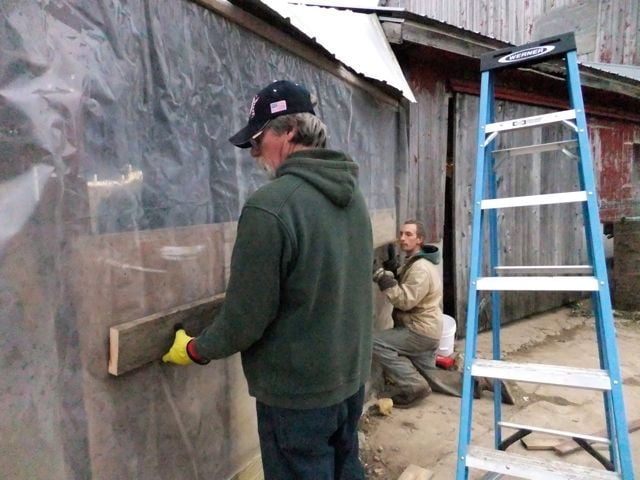
Larry and Noah winterize the outdoor washroom. It’s too cold to work in this space during winter but we appreciate the protection from wind and snow drifts. We will store equipment in here until spring.
Things you need to know about your winter share.
* Your delivery will consist of two different boxes, labeled “A” and “B”. The boxes contain different vegetables. Take one “A” box and one “B” box.
* Please pick up your boxes on the day of delivery, during the normal hours for your site. Don’t count on picking up late or the next day. It will be cold during the deliveries and the produce may freeze overnight at the unheated sites.
* We are sending all of the winter squash in this first delivery.
* Don’t feel that you have to eat all this food before the second delivery! Much of it will store quite well. See below.
* The second (and final) winter share delivery will be on Thursday December 12 (Madison, Middleton, Oregon and Evansville) and Friday December 13 (Milwaukee area, Janesville).
* Local Thyme is not supplying specific recipes for the winter boxes. However, we have access to the entire catalog of Local Thyme recipes all winter. Check them out for your Thanksgiving ideas.
Winter share strategy
* These vegetables are the most perishable: scallions, bok choy, and butternuts with flaws.
* These are the next-most perishable: cranberries, leeks, Brussels sprouts, butternut squash. Watch your winter squash closely and use quickly if you see any signs of deterioration.
* These will last the longest: Beauty Heart radish, beets, carrots, garlic, onions, potatoes, sweet potatoes.
Veggie List and Storage Info (winter share, delivery #1)
Box “A”
Butternut squash, 1 large and 1 medium
Satina yellow potatoes, 5 lb
Adirondack Blue potatoes, 3 lb
Sweet potatoes, 5 lb
Garlic, 1 small bulb
Box “B”
Beauty Heart winter radish, about 2
Golden beets plus some “Badger Gold” beets, 3 1/3 lb total
Brussels sprouts, 1.5 lb
Carrots, 5 lb
Cranberries, 1 pint
Leeks, 3 lb
Scallions, 1 bunch
Yellow onions, 5 lb
Bok choy, 1 medium head
Here’s what we think will be in the December delivery: beets, green cabbage, red cabbage, carrots, celeriac, leeks, onions, parsnips, russet potatoes, yellow potatoes, rutabaga, sweet potatoes, Beauty Heart winter radishes.
Beets – Refrigerate in a plastic bag. Beets will store for two months or longer. You will receive a mix of golden beets (2 1/3 lb, round, gold inside) and “Badger Gold” beets (1 lb, longer, russeted skin on shoulders, striped inside). Remember our collaborative carrot trial with research scientists from UW/Madison this summer? “Badger Gold” was developed by Prof. Irwin Goldman of the Horticulture Department. It will be one of the first varieties to be released through the radical Open Source Seed Initiative (OSSI). It is an excellent, sweet golden beet, with lovely concentric rings inside. Irwin says it is even good raw. We were thrilled that Irwin offered us a bit of seed to try this year. It is not available for sale yet, so this is the farmer-equivalent of getting past the velvet rope at an exclusive club.
Bok choy – Refrigerate and use soon.
Carrots. Refrigerate in a plastic bag. Will keep for several weeks.
Cranberries. Refrigerate. Freeze if you don’t expect to use within several weeks. These organic cranberries are from Ruesch Farms in central Wisconsin. They are of very beautiful quality because they were harvested by ‘dry raking’ instead of a wet harvest in which the field is flooded. Brian Ruesch says that dry raking is more work for them but preserves the quality and storage life of the cranberries.
Garlic. Can be stored at room temperature. As I mentioned in previous newsletters, the midwestern garlic crop failed this year so we only have one small bulb for each of you.
Leeks. Refrigerate and eat within three weeks. Leeks are not a long-storage crop. You may need to strip off one or two outer leaves to freshen the leeks before you cook them.
Onions: Store in a cool, dark spot or refrigerate. Protect from light. Exposure to light stimulates sprouting.
Potatoes: Can be stored at room temperature or in a cool spot, but must be kept in the dark, or they will turn green. They will store longer if kept cool. Around 40 – 50 F is ideal. Keep them in the paper bag we sent them in, or cover the potatoes with a cloth. The potatoes are from Chris Malek of Malek Family Stewardship Farm. Everyone will receive 5 lb. Satina potatoes. These have light yellow flesh and are a good all-purpose potato. Everyone will also receive 3 lb of blue-fleshed potatoes. They are a pretty addition to roasted potato dishes.
Sweet potatoes – Wow, the sweet potato crop turned out so well this year. These are the Covington variety, and have developed excellent flavor and sweetness. Store at room temperature, no lower than 55 F. Keep them on your kitchen counter where it’s easy to keep an eye on them. The roots come in a wide ranges of sizes and all are good. The sweet potatoes are not washed. We don’t like to wet them this time of year without a warm place to dry them.
Winter squash – You will receive two butternut squash, one large and one medium. Almost all are our Waltham variety which tends to grow big squashes. Some squash have minor flaws. Identify and use that squash first. Store winter squash in a cool, dry place. 50 F is ideal. Do not put in a plastic bag. Inspect your squash frequently and cook if you see any soft spots developing. You can cook, mash and freeze the squash for future use. I find that you can refrigerate cut raw squash for up to one week. This runs counter to the accepted way to store squash, but is useful if you want to cook just half a squash at one time. Try microwaving your squash for one to two minutes before cutting or peeling. This softens the squash and makes large butternuts easier to handle.
What are you planning for your Thanksgiving meal?
I thought I’d share our plans. We are a family of cooks. We plan to prepare a heritage breed turkey from Matt Smith at Blue Valley Gardens, brined overnight (Beth), stuffing (Beth’s mom), Brussels sprouts with garlic-mustard vinaigrette (Steve), roasted sweet potatoes (Sophie), glazed butternut squash (Beth), crunchy carrot-Beauty Heart salad with sesame-seed dressing (Steve), homemade applesauce (Ari), pickles (Ari), cranberry sauce (friends), and apple pie (Sophie). We love Thanksgiving!
Leek-Vegetable Fritters With Lemon Cream
While packing CSA boxes, crew member Jon rapsodized about a leek fritter recipe he enjoys. It was a chilly day and we were getting hungry. I think every person went home and made those leek fritters, including me. They are tasty and mild, true comfort food. I’ll list the ingredients here, and you can read the recipe online. We skipped the sour cream and used Greek yogurt instead. The recipe is from Deb Perelman of Smitten Kitchen.
For the fritters:
2 pounds leeks, pale green and white parts only (or use 1 pound leeks and 1 pound cooked vegetables like carrots, potatoes, summer squash, beets, zucchini)
Salt
2 scallions, trimmed, halved lengthwise and thinly sliced
1/4 cup all-purpose flour
1 teaspoon baking powder
Freshly ground black pepper
Pinch cayenne
1 egg
Vegetable oil, for frying
For the cream:
1/2 cup sour cream
1 tablespoon freshly squeezed lemon juice
Pinch freshly grated lemon zest
Salt
Read the recipe here.
Goodbye.
- On: November 13, 2013
 0
0
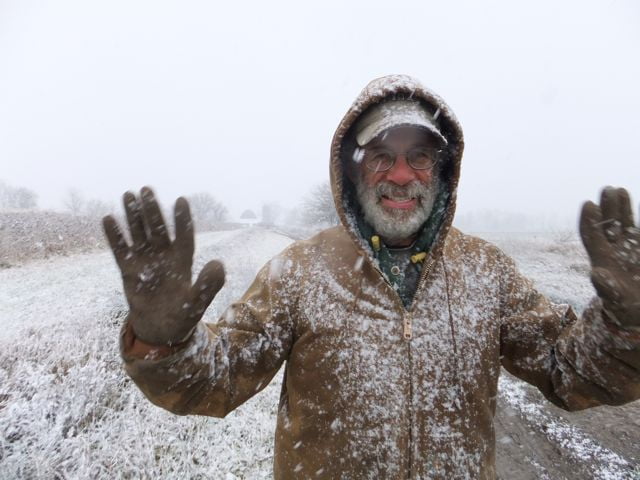
The snow showers on Monday were dramatic. Steve waves good bye and looks forward to his winter rest.
This is the final week of our regular CSA season. We would like to thank each of you for joining our farm this year. We appreciate your support and encouragement. We hope you enjoyed the produce and the experience. It was a good year, from our perspective. The late spring was frustrating but we found ourselves racing to keep up with the crops by summer. Moisture was erratic; we got seven inches in June, then almost no rain for two months. It was a good year for almost everything in the Brassica (cabbage) family, with loads of broccoli and surprisingly early harvests of cauliflower and Romanesco broccoli. The cabbage are dauntingly big. Pepper harvests were below average. We sent most of the peppers in the CSA boxes (instead of to our store customers) so maybe it wasn’t noticeable. Tomatoes and melons did great! This was our longest strawberry season ever. We have no complaints about that.
We were fortunate to gather an enthusiastic work crew this year. Steve struggled through midseason without an assistant farmer until Larry stepped in with his ability to fix anything. Our workers have begun moving on to their winter jobs. Many work at farms with winter greenhouse or hoophouse production. Others will travel, waitress, or nanny. One will drive a taxi cab. A few will work with us through the winter preparing our stored carrots and other crops for sale to the Willy Street and Outpost coops. Steve and I look forward to some quiet time to play with our kids and plan next season. Have a great winter! Beth
2013 Survey.
Tell us your thoughts on our CSA season. Use the link in this week’s email. We are particularly interested in members’ vegetable preferences, and whether the Local Thyme menus were useful. Here is your chance to tell us how to improve your CSA deliveries. We will carefully read through your comments this winter, and will incorporate your feedback as we plan next season.
2014 Registration.
We are preparing to open 2014 CSA registrations. Watch for an email from us soon. There will be an opportunity to register early at our 2013 rates. We will open registration for new members after December 1.
Final Details.
– Please make sure that everyone who participates in your CSA share knows the CSA has finished.
– Please return all empty CSA boxes this week. It’s best to unpack your box this week, and leave it behind. It’s OK to leave empty boxes at your site during the next two weeks.
– Our Local Thyme subscription is good for an entire year, so you have access to their website and recipes until spring. Use it this winter!
Food Safety Modernization Act Comments are due November 15.
See last week’s post for more info. Thanks to those of you who already submitted your comments,
Veggie List and Veggie Notes (week #26, green EOW)
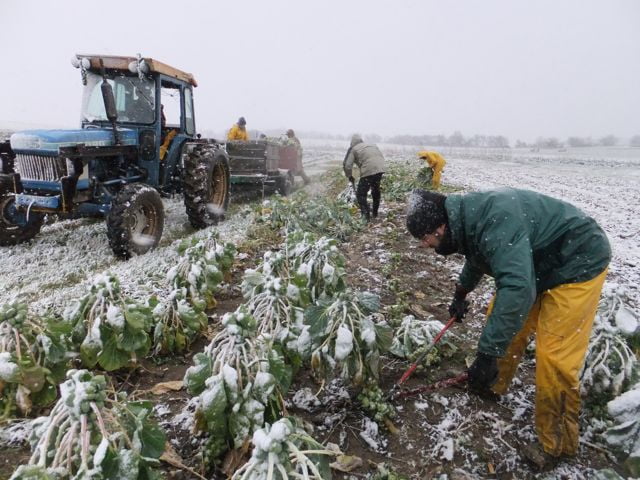
The crew gathered Brussels sprout stalks during the snow on Monday. Alex clips stalks while Carla, Clint, Michael, Bri and Steve load them on the wagon. We brought them back to the buildings so everyone could work inside the warm barn while snapping individual sprouts from the stalks.
Green cabbage, 1 large
Sweet potatoes (unwashed), about 2 lb
Brussels sprouts, 1 lb
Butternut squash
Beets, 2 lb
Celeriac, 1 root
Carrots, 2 lb
Onions, about 2
Sweet potatoes – As I explained last week, we dry-brushed the soil off the sweet potatoes. It is too risky to wash them this time of year without a warm place to dry them. Store your sweet potatoes at room temperature.
Butternut squash – Similarly, we dry-brushed the butternuts, but they will need more thorough washing.
Brussels sprouts – If you are a new CSA member, please approach Brussels sprouts with an open mind. Many of us grew up eating awful, overcooked Brussels sprouts. These Brussels sprouts are completely different. Here is how we cook Brussels sprouts: Wash the sprouts and trim the cut ends. Cut an X in the stem end of large sprouts. Cut a single slit in small or medium sprouts. This does two things. It helps the Brussels sprouts cook evenly, plus it allows them to soak up any marinade or dressing. Place in a pot with one inch of water in the bottom and steam until tender, 7 to 10 minutes. If the sprouts are uneven in size, then set aside the smallest ones and add to the pot after the larger ones have cooked for a few minutes. Don’t overcook them! You can also oven-roast Brussels sprouts. Here are a few dressing ideas for cooked sprouts:
– Sherry vinegar/olive oil/Dijon mustard/garlic/white wine/salt and pepper
– Balsamic vinegar/olive oil/garlic/salt and pepper
– Lemon juice and zest/melted brown butter/poppy seeds/white wine/garlic/salt
URGENT: Please comment on the food safety act
- On: November 06, 2013
 0
0
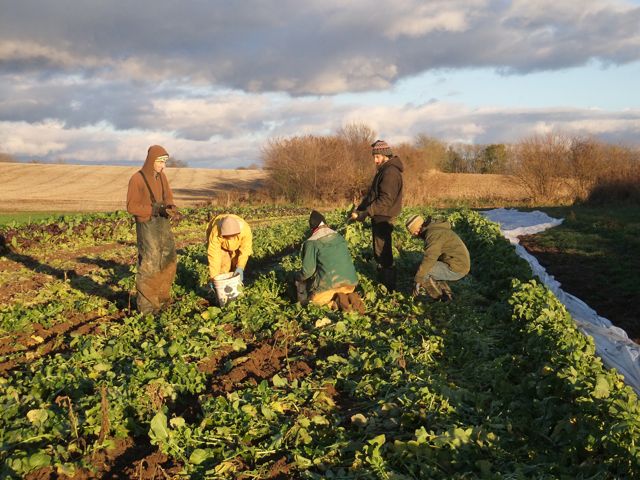
The crew harvests winter radishes. It was too muddy to use our mechanical root harvester, plus we find that harvesting by hand is easier on the brittle radishes. From left, Jon, Kelty, Alex, Clint, and Kyle.
Purple EOW members, this is your final delivery (November 7/8).
Weekly and green EOW members, you will receive your final box next week (November 14/15)
Wrap-up for purple EOW members. Thank you for being members of our farm this year! We hope you have enjoyed the experience. A few thoughts:
– Please read next week’s email for our annual survey. We will incorporate your comments into our plans for next year.
– Please return all your empty CSA boxes.
– We expect to open 2014 registration soon for returning Tipi members. Watch for emails from us.
Please comment on the Food Safety Modernization Act
The Food Safety Modernization Act (FSMA) is a piece of legislation currently under review by the Food and Drug Administration. It is an intimidating set of regulations that seek to overhaul food safety in the USA. There are sound ideas in the act, such as protecting fresh produce from exposure to raw manure. Unfortunately, this complex piece of legislation has enough bad ideas to drive many small and medium vegetable farms out of business. As summarized by the Michael Fields Agricultural Institute, “The (FDA)’s first draft of new safety rules has big problems. They will be costly, especially for smaller farmers. They conflict with National Organic Program rules and undermine conservation practices. They undercut CSAs and other essential markets in local food systems. What is bad for our farmers is bad for our consumers.”
Will it put us out of business? No, but it will make our job much more difficult, without improving the quality of your food.
The National Sustainable Agriculture Coalition (NSAC) has done a good job summarizing the current draft of the legislation. Go to the NSAC website to learn more about the Food Safety Act, and to read their assessment of the top problems with the proposed regulations.
The FDA is accepting comments on the FSMA until November 15. If you are concerned about maintaining your community of local farms, we encourage you to submit a comment to the FDA.
The Sustainable Ag Coalition has a good instructions on how to submit an effective comment, as well as links to the government submissions pages. We encourage you to submit your comment under both the Produce Rule and the Preventative Controls Rule. Our farm and CSA (and your food supply) will be affected by both pieces of legislation. Beth
Steve’s take on the Food Safety Modernization Act.
We don’t often talk with you about the cultural and political pressures that affect us as organic famers. Something is brewing that we want you to know about. The U.S. Food and Drug Administration (FDA) is putting together an administrative rule called the Food Safety Modernization Act (FSMA). Congress authorized this act, intending to improve the safety of the American food supply.
The FSMA, as currently drafted, would have a huge negative effect on our farm and other similar small and medium-sized vegetable farms, whether organic or conventional. The food safety rules call for extreme preventative measures that have not been shown to reduce foodborne illness. The FDA expects that compliance would cost a farm like Tipi about $30,000 per year. Smaller, younger farms could spend half their net income meeting these standards, forcing them out of business.
The whole draft rule is over 3,000 pages. I have not read all of it, but have gone through a few especially relevant topics. I’m relying on small farm and sustainable ag advocates who have digested and summarized this sprawling document.
The FSMA, as written in draft, is a true threat to the locally-oriented organic farms that feed you through CSAs, food coops, farmers’ markets and farm-to-school programs. See above for links to some well-researched information.
The FDA is taking comments on the FSMA rules through next Friday November 15. We ask you to help stop this damaging regulation by sending a short comment to the FDA. You don’t need to be overly technical. A comment like the one below (in your own words of course) would register your opinion:
“We are CSA members in Wisconsin and our family (or household) eats more fresh produce because of our CSA commitment. Do not put burdensome, unproven mandates on our farmers! We trust their food and their judgement. Your proposed FSMA rules would damage the local farms that we depend on for safe, high-quality food.”
Thank you for your time considering this. Steve
Veggie List and Veggie Notes (week #25, purple EOW)
Tip for cutting winter squash: If you want to peel or dice your butternut squash, microwave the intact squash on high for one minute. That’s enough to warm and soften the squash, making it much easier to peel. I find this trick useful even when just cutting the butternut in half.
Russet potatoes, about 3.5 lb
Sweet potatoes (unwashed), about 2 lb
Butternut winter squash
Collard greens
Leeks, about 1.5 lb
Carrots, 2 lb
Beauty Heart radish, 1 lb, about 2
Onion, 1
Broccoli, 1 modest head or some side shoots
Next week’s box will probably contain green cabbage, butternut squash, sweet potatoes, beets, celeriac, carrots, onions and Brussels sprouts.
Russet potatoes – Chris Malek sent us big beautiful russets this week, perfect for baking.
Sweet potatoes – These are unwashed. Sweet potatoes need warm storage. It is too risky to wash them this time of year without a warm place to dry them, so we ran them through a dry brusher to knock off most of the dirt. This delivery is mostly the Beauregard variety. Here are a few things we’ve learned about sweet potatoes:
– Store your sweet potatoes at room temperature. They suffer chilling injury below 50 F.
– The sweet potatoes we grow require slightly longer cooking than ones from the supermarket, perhaps because they contain higher moisture so soon after harvest. Cook thoroughly for best flavor and texture.
– Sweet potatoes are good at any size. We have cooked everything from tiny to jumbo and consistently find that all sizes taste good.
– We have a new favorite way to roast sweet potatoes. We used to prepare sweet potato fries. Now we just quarter the potatoes, rub with olive oil, dust with salt and place cut-side-down on a cookie sheet. Roast in a 450 F oven without turning until soft. The flavors will caramelize (like sweet potato fries) but preparation is simpler and the cooking time less exacting. Slender sweet potato fries go from undercooked to overcooked in the blink of an eye.
Butternut winter squash – Almost everyone will receive the JWS6823 variety. We tried several new winter squash varieties this year. This one did quite well and has good flavor. This variety produces small squash, about the same size as the Metro we sent a few weeks ago.
Collard greens – These end-of-season collards need more extended cooking than tender spring-grown collards. They can handle long braising or simmering. Remove the midveins before cooking.
Beauty Heart radish (round, white and pale green exterior, bright pink interior) – The interior color is lovely. Slice thinly and add to salads, cook lightly in mixed vegetable medleys or cut into matchsticks and add to pasta salads. We enjoy grated carrot and Beauty Heart salads all winter.

